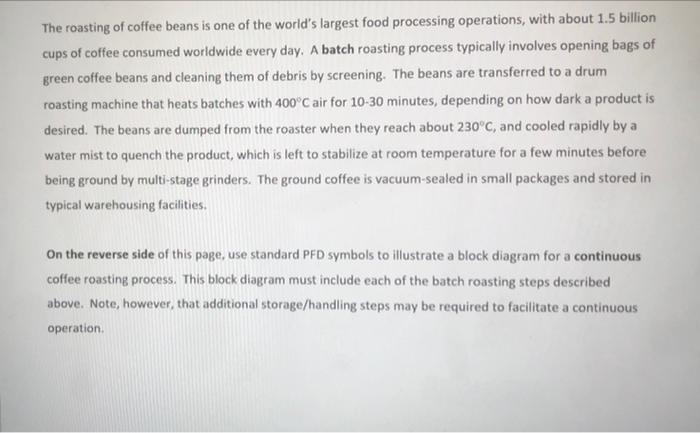The roasting of coffee beans is one of the world's largest food processing operations, with about 1.5 billion cups of coffee consumed worldwide every day. A batch roasting process typically involves opening bags of green coffee beans and cleaning them of debris by screening. The beans are transferred to a drum roasting machine that heats batches with 400C air for 10-30 minutes, depending on how dark a product is desired. The beans are dumped from the roaster when they reach about 230C, and cooled rapidly by a water mist to quench the product, which is left to stabilize at room temperature for a few minutes before being ground by multi-stage grinders. The ground coffee is vacuum-sealed in small packages and stored in typical warehousing facilities. On the reverse side of this page, use standard PFD symbols to illustrate a block diagram for a continuous coffee roasting process. This block diagram must include each of the batch roasting steps described above. Note, however, that additional storage/handling steps may be required to facilitate a continuous operation The roasting of coffee beans is one of the world's largest food processing operations, with about 1.5 billion cups of coffee consumed worldwide every day. A batch roasting process typically involves opening bags of green coffee beans and cleaning them of debris by screening. The beans are transferred to a drum roasting machine that heats batches with 400C air for 10-30 minutes, depending on how dark a product is desired. The beans are dumped from the roaster when they reach about 230C, and cooled rapidly by a water mist to quench the product, which is left to stabilize at room temperature for a few minutes before being ground by multi-stage grinders. The ground coffee is vacuum-sealed in small packages and stored in typical warehousing facilities. On the reverse side of this page, use standard PFD symbols to illustrate a block diagram for a continuous coffee roasting process. This block diagram must include each of the batch roasting steps described above. Note, however, that additional storage/handling steps may be required to facilitate a continuous operation







